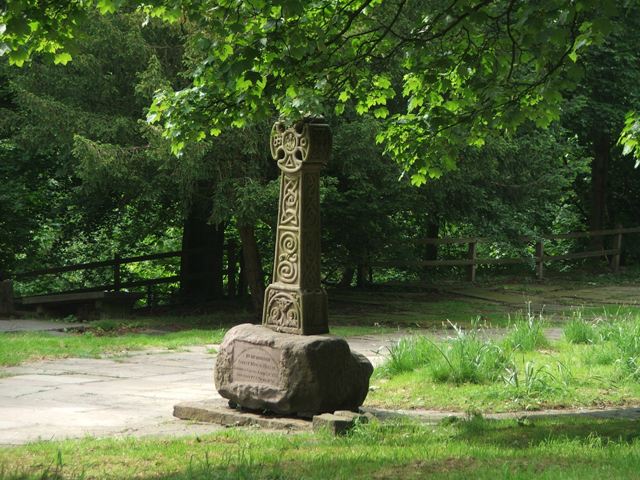George Marsh Cross

Where the paths from the south door and the Hulton door meet stands the George Marsh Memorial Cross. The base of the cross is reputed to have been the base of an ancient Saxon cross from which early Christian preachers taught. It stood some half a mile to the west of the church on Broadgate Road (the old name for Junction Road). Inscriptions on the base record the martyrdom of George Marsh and the erection of the memorial by Rev. H.S.Patterson in 1893, and also the removal of the stone from its original site.
For clarification, the stone base was discovered at New York, off Junction Road. The cross was designed and added during the incumbency of Rev H.S.Patterson. The base stone apparently had a cavity in it, probably to support an earlier cross. In chapter 81 of Dawson's 'Records and Traditions ...' there is a suggestion that the original cross may have been demolished in the 1520s at the same time as the desecration of the St Ann and Holy Trinity chapel.
George Marsh was born at Broadgate in the year 1515. His father was a farmer. He attended either Bolton Grammar School or a school in Farnworth. He became a farmer and married at age of twenty-five. After the death of his wife he left his children in the care of his parents and entered Cambridge University. Here he associated with several ardent advocates of the reformed faith. He attached himself to one Lawrence Sanders. After preaching in various parts of the country he became curate to Sanders at All Hallows Church, London. When Sanders was arrested, George Marsh came north and preached the Protestant faith at Deane, Eccles, and elsewhere. Learning that Justice Barton, of Smithills Hall, had sent servants to arrest him at his mother's house, in spite of his friends' earnest entreaties, he gave himself up at Smithills. Local fervour was so great that the story was told of Marsh stamping his foot with such determination that the imprint of his foot remained on the stone flag. The story became traditional, and a stone with the mark of a foot, protected by iron bars, is still inspected by visitors to Smithills Hall.
From Smithills, George Marsh was taken to the Earl of Derby at Lathom House, then to Lancaster Castle, and finally to Chester. In spite of the pleadings of friends and some of his judges he refused to deny his faith. He was condemned and burned at the stake at Spital Boughton, Chester, on April 24th, 1555. His ashes were interred in the burial ground of St.Giles's Chapel, Spital Boughton, and a memorial in the form of an obelisk now stands near the scene of his martyrdom. There is also a memorial tablet to the martyr in St.John's Church, Chester.
The story of George Marsh is included in Foxe's Book of Martyrs and on our dedicated page.